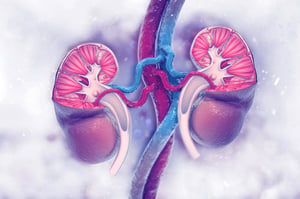Transition of Care for Persons with CKD - 2018
(Gleaned from the 2018 USRDS Annual Data Report: Volume 1, Chapter 9: www.usrds.org)
The Transition of Care in Chronic Kidney Disease (TC-CKD) Special Study Center examines  the transition of care to renal replacement therapy (dialysis or transplantation) in patients with very-late-stage (advanced) non-dialysis dependent CKD. These are often persons with an estimated glomerular filtration rate (eGFR) <25 mL/min/1.73m2.
the transition of care to renal replacement therapy (dialysis or transplantation) in patients with very-late-stage (advanced) non-dialysis dependent CKD. These are often persons with an estimated glomerular filtration rate (eGFR) <25 mL/min/1.73m2.
In a special USRDS study, the most recent Veterans Health Administration (VHA) and Kaiser Permanente Southern California (KP-SC) cohorts of incident ESRD patients were analyzed to test the hypotheses that a pre-ESRD, data-driven, personalized approach to the transition of care into ESRD in very-late-stage, non-dialysis-dependent CKD is associated with more favorable outcomes, particularly if the decision is based on pre-ESRD factors such as clinical and laboratory variables, including CKD progression rate, comorbid conditions during the prelude period and demographics.
In the 2016 Annual Data Report, data on approximately 85,000 incident ESRD veterans who transitioned to ESRD over 6.5 years (from 2007-2014) across the entire nation was presented. The following year, similar data was presented on more than 100,000 incident ESRD veterans who transitioned (from 2007-2015). In the 2018 Annual Data Report, additional data on these 100,000 veterans, including comparisons with the entire USRDS cohort that transitioned over that period, seasonal trends, and variations across the United States were presented. Also included was data on the racially and ethnically diverse Kaiser-Permanente Southern California member population who transitioned to ESRD over 10 years between from 2007-2016. Highlights include:
- Compared to all USRDS patients who transitioned to end-stage renal disease (ESRD) between 2007-2015, U.S. veteran patients were older, more likely to be non-Hispanic and White, more likely to have cardiovascular or pulmonary comorbidities, and more likely to have pre-transition nephrology care or have an arteriovenous (AV) fistula as their primary access type
- Kaiser-Permanente-Southern California (KP-SC) patients were younger. Of KP-SC patients who transitioned to ESRD between 2007 and 2016, 20% were Black, 37% Hispanic, 11% Asian, and 42% female.
- Female U.S. veterans comprised less than 2% of all USRDS females transitioning to ESRD between 2007-2015. Female veterans’ characteristics were similar to the total USRDS female population transitioning to ESRD during the same period, with the exception that they were more likely to be Black.
- The median estimated glomerular filtration rate (eGFR) at transition for U.S. veterans was higher than that of the total USRDS population. The highest median eGFRs at transition were found in North Dakota, Idaho and Arizona, while the lowest was in South Carolina, the District of Columbia and Alabama. Females had lower median eGFRs at the transition to ESRD, compared to males.
- Across states, U.S. veterans showed different proportions and temporal changes in the proportions of patients with diabetes or hypertension as the primary cause of ESRD, preemptive transplants, AV fistula or AV graft as the initial access type, cardiovascular disease and infection-related cause of death, and hospitalizations during the transition.
- Of the 12,242 KP-SC patients who transitioned to ESRD, 315 (2.6%) had a preemptive transplant and 1,731 (14%) initiated dialysis with peritoneal dialysis (PD). Hemodialysis (HD) catheter was the most frequent access type at the initiation of dialysis, while AV grafts remained the least frequent access type.
- In the year prior to ESRD transition, the median eGFR decreased from 18.4 to 11.2 mL/min/1.73m2 among 11,927 KP-SC patients. Younger patients had a more rapid decrease of eGFR than older ones. Patients with diabetes had a faster progression rate of eGFR than those with other health conditions.




